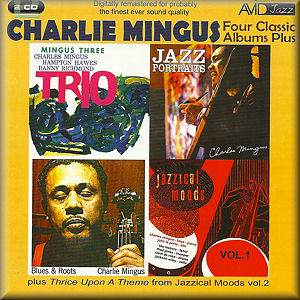CD1
Blues and Roots
1. Wednesday Night Prayer Meeting
2. Cryin' Blues
3. Moanin'
4. Tensions
5. My Jelly Roll Soul
6. E's Flat Ah's Flat Too
Mingus Three
7. Yesterdays
8. Back Home Blues
9. I Can't Get Started
10. Hamp's New Blues
11. Summertime
12. Dizzy Moods
13. Laura
CD2
Jazz Portraits
1. Nostalgia In Times Square
2. I Can't Get Started
3. No Private Income Blues
4. Alice's Wonderland
Jazzical Moods Vol. 1
5. What Is This Thing Called Love
6. Stormy Weather
7. Minor Intrusion
8. Abstractions
Jazzical Moods Vol. 2
9. Thrice Upon a Theme
Charlie Mingus - Bass, piano
John Handy - Alto sax (tracks I/1-6, II/1-4)
Jackie McLean - Alto sax (tracks I/1-6)
Booker Ervin - Tenor sax (tracks I/1-6, II/1-4)
Pepper Adams - Baritone sax (tracks I/1-6)
Jimmy Knepper, Willie Dennis - Trombones (tracks I/1-6)
Horace Parlan, Mal Waldron - Piano (tracks I/1-6)
Dannie Richmond - Drums (tracks I/1-13, II/1-4)
Hampton Hawes - Piano (tracks I/7-13)
Richard Wyands - Piano (tracks II/1-4)
John La Porta - Alto sax (tracks II/5-9)
Teo Macero - Tenor sax (tracks II/5-9)
Thad Jones - Trumpet (tracks II/5-9)
Clem De Rosa - Drums (tracks II/5-9)
Jackson Wiley - Cello (tracks II/5-9)
All these recordings date from the 1950s, after Charlie Mingus had come to prominence for his work with the Red Norvo Trio and his appearance at the famous Massey Hall concert in 1953 with Charlie Parker and Dizzy Gillespie. The fifties were the decade when Mingus concentrated more on composition, forming his own groups to develop his particular maverick creations.
The first LP from which this double CD is compiled is Blues and Roots from February 1959, one of the high points in Mingus's career. It developed from Nesuhi Ertegun's suggestion that Charlie should record a whole album of the blues, because some critics were saying that Mingus's music didn't swing. The album stood out because it blended the blues with a "roots" element - particularly drawing on the gospel music which Mingus knew as a child.
Wednesday Night Prayer Meeting is the perfect example of this mixture: a jazz waltz but unlike any jazz waltz we had heard before. It typifies Mingus's mature style of organised anarchy - giving the musicians the outlines on which they could improvise. It includes fine solos from John Handy and Booker Ervin and a notable section where the saxophone is accompanied only by handclaps. The holy-rolling atmosphere is accentuated by cries and shouts in the background.
Moanin' (another Mingus composition) also conjures up the confused mel‚e of a gospel meeting. Mingus was a difficult, tortured soul whose music reflected his intensity and originality but also his roughness and confusion. Yet he also valued the jazz tradition created by such pioneers as Jelly Roll Morton and Duke Ellington, as you can hear in My Jelly Roll Soul.
The next seven tracks come from the 1957 album Mingus Three which uses the conventional format of a piano trio but takes it in a new direction. As Nat Hentoff's original sleeve-notes said, it is basically a conversation betwen pianist Hampton Hawes and Mingus on bass, with punctuation from drummer Dnnie Richmond. Mingus's deep, resonant tone ensures him a place in the foreground. In fact he states Tea for Two as a counter-melody to Laura. Listeners who are put off by Charlie's lawlessness may be more attracted by this understated session.
Jazz Portraits was a session recorded in January 1959 by a splendid quintet fronted by John Handy and Booker Ervin. The sleeve-note says that this was the first recording session for both men, although Ervin had actually recorded earlier with the rhythm-and-blues group of Ernie Fields. The opening Nostalgia in Times Square has understandably become a jazz standard, with its catchy melody and hint of a marching beat. Here it seesaws between fast and slow tempos. All four tracks on this LP were recorded live in New York and none is shorter than about nine minutes, alllowing plenty of leeway for the musicians' expression, with John Handy particularly eloquent in I Can't Get Started. No Private Income Blues is notable for the interplay between Handy and Ervin, often accompanied only by snippets from the Mingus double bass.
The last five tracks are the earliest recordings in this compilation: taken from two 1954 volumes of Jazzical Moods. These show Mingus experimenting and still, in a way, uncertain which path to take. Thad Jones supplies some masterly trumpet solos but the musicians sometimes sound uncomfortable with the unconventional roles they are expected to play.
So this double album is a mixed bag - most valuable for including such masterpieces as Wednesday Night Prayer Meeting and Nostalgia in Times Square. I have followed the album's practice of giving Mingus's first name as Charlie, even though he disapproved of it, saying: "Don't call me Charlie; that's not a man's name, that's a name for a horse".
Tony Augarde
www.augardebooks.co.uk
